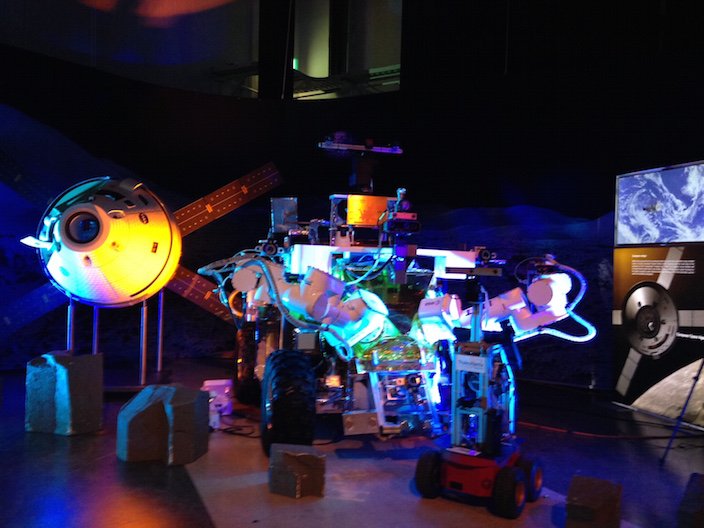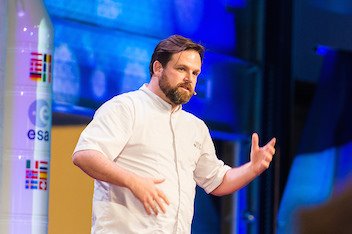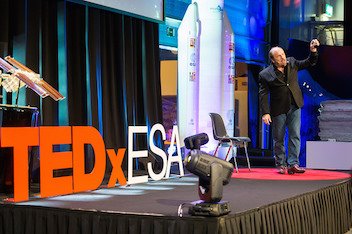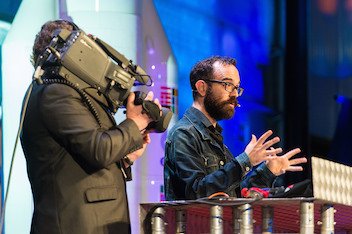Last Wednesday, November 11th I flew to the European Space Agency’s Research & Technology Centre (ESTEC) in Noordwijk, The Netherlands, to attend their TEDxESA event, which was themed on Science Beyond Fiction, an investigation into the future of space and predicting what that might be like, from a scientific and human context. Hosted at their stunning Erasmus centre, this is the exhibition space and showcase for the Directorate of Human Spaceflight’s programmes and missions, which houses models of ESA’s Columbus scientific research pod on the International Space Station, as well as Mars and Lunar rovers. The space was beautifully staged and we were given plenty of time to wander around and inspect further.

The event was hosted by ESA Astronaut, Andre Kuipers, a hero to many Dutch attendees who felt it privilege enough to be in his company, and who very graciously and patiently stood in for photos and selfies, and took the time to speak to all who approached him, this warm and generous manner kept the ball rolling throughout the evening’s proceedings.
The first part of the event focussed on the Science part of the TEDx theme of Science Beyond Fiction, as we heard from Tommaso Ghidini a specialist in fracture mechanics and materials who shared a variety of 3D printed spare parts designed for ISS. Then Danko Nikolic, from the Max-Planck Institute for Brain Research took us through the reality of our evolving reliance on robots in the years ahead as we aim towards Mars and beyond.

Danish chef Thorsten Schmidt told us about the 4 course meal he prepared for the astronauts to celebrate the installation of a new espresso maker on the ISS last April. The coffee maker was sent up during Italian ESA Astronaut’s Samantha Cristoforetti’s mission. Schmidt told us that his biggest challenge was, after finalizing the menu, to figure out how to squeeze six sets of four course meals into a space restriction about the size of a shoebox. Then he announced that he had hidden the same dessert under each of our seats, for us all to taste together- SpaceRock- a sort-of dark chocolate truffle coated in that exploding space rock we ate as kids, which pops in your mouth. Yum. It didn’t last long!

The first half finished with Andre in conversation with Scott Millican, a veteran of the early NASA manned missions in the 1960s, who worked on the Gemini and Apollo missions. The more he spoke, the more he became the Forrest Gump of NASA history, as he appeared in countless iconic images of these early NASA missions, quietly in the background, but sharing the frame with Gene Kranz, Neil Armstrong, Buzz Aldrin and more. He shared his experiences of the infamous Apollo 13 mission, when many engineers frantically worked on a solution to attach a square device to another round receptacle to provide life-saving oxygen to the Apollo 13 team stranded near the surface of the moon.
Scott brought with him an original copy of one of the procedures manual for a NASA Apollo mission- we often forget a time before home computers, downloads and mobile phones and struggle to imagine the time involved in creating these documents by hand. When Scott told us that the procedure for the astronauts to make that same ‘square device to round receptacle’ solution aboard the Apollo 13 spacecraft, the detailed instructions had to be read out line by line to the astronauts as they painstakingly transcribed them, you realise the enormous effort involved in those early missions and how much technology has transformed our lives and space exploration.

With a humble and gracious style, Scott’s stories were a fascinating snapshot of that moment in history from a small but very crucial part of a very big team in making the moon landings happen all those years ago. And Andre facilitated this conversation with a gentle and personal tone, as we were brought back to that time in NASA history, through Scott’s masterful re-creation of it. You could have devoted the whole night to this conversation, but there was too much to get through. And it was time for a little break.
There was another opportunity to wander about the facility during the interval and catch up with some of my Space Studies Programme alumni and reach out to ESA staff and researchers. It was also an opportunity to chat with some of the senior members of ESA, including Frank de Winne, ESA Astronaut and current Head of European Astronaut Centre, Fernando Doblas, head of ESA Communications, and ESA Director Franco Ongaro. We were in the presence of true ESA royalty and I appreciated my ticket to this event all the more.
The second half of TEDxESA then shifted focus to the Fiction aspect of Science Beyond Fiction theme, which kicked off with BBC comedian Helen Keen, then we had visionary Rick Tumlinson, author and futurist Nick Harkaway and young Aeronautical engineering graduate and ESA intern Kanika Anand.

The most anticipated speaker for me was from our most recent ESA Astronaut on the ISS, Italy’s Samantha Cristoforetti, who clocked up a whopping 199 days aboard the International Space Station and recently returned to Earth last June while I was attending the Space Studies Programme. While on that programme, many of us got up early and watched her re-entry on the Soyuz live from a room in Ohio University. She was fascinating in the re-telling of her experiences aboard the ISS, and that day the espresso coffee machine arrived. As with Scott Millican, Samantha’s stories were fascinating and warranted her own separate event, but as with all TEDx events, 20 minutes is all that’s available before you are on to the next speaker.
The final act of the night was musician and creative technologist Peter Kirn who performed an audio mash-up techno mix of sounds that he had gathered throughout the night and mixed into dance beats.

The TEDx team then closed the night and asked us if we thought we should have another TEDxESA event. And with a resounding yes from the room, Frank de Winne, Head of the Astronaut Centre in Cologne came to the stage and accepted the challenge to host the next TEDxESA at EAC next year.
You cannot help but have your favourite speakers (which for me was Scott Millican and Samantha Cristoforetti) but everyone certainly brought something unique and interesting to the Science Beyond Fiction debate. As TEDx events go, this one was pretty special and curated very well by a team led by ESA Technology Transfer Programme Office. I chatted with Natascha de Waal, one of the organizers, who told me that the concept behind the night was to provide a platform to generate debate about Space, pivoting the discussion on turning dreams into ideas and ideas into reality. Well it’s fair to say that the night succeeded in that objective. It was a really great night for all us space enthusiasts, but more than that, the discussion had a far greater reach and provoked better conversations about the role of space exploration in future society.
